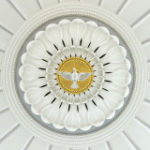Welcome to the most historic place of worship in the United States! In 1806 the first bishop of the United States, John Carroll, laid the cornerstone for this first Cathedral in our land. The only master architect in the infant United States, Benjamin Henry Latrobe, was then working for President Thomas Jefferson in supervising the design and construction of the first Capitol building in Washington. He heard that Bishop Carroll had in mind the building of a cathedral and he volunteered his services pro bono.
Because the United States had completed the Louisiana Purchase two years earlier and Bishop John Carroll had been named Apostolic Administrator of New Orleans, the cathedral was to serve the Catholics then living in what are today 36 States of the Union! Incidentally, the Diocese of Baltimore, as established in 1789, comprised the thirteen original states and the Northwest Territory, our present Middle West. In 1810 it was divided, and the first bishops of Philadelphia, Boston and Bardstown, Kentucky were ordained here in Baltimore. The first bishop of New York was ordained a bishop in Rome, but never reached his diocese; he fell ill and died in Naples, and the new Bishop of Boston was assigned to shepherd Catholics in New York until another bishop could be sent.
Another bit of history is worth remembering this evening: Maryland was the first place in the English-speaking world to have religious freedom. In 1634, King Charles I of England granted to Lord Baltimore the possibility of such freedom in the new colony, and the colonists enacted in 1639 and in 1649 laws spelling out their freedom, making sure that government would not involve itself in matters of worship or conscience. With the so-called Glorious Revolution of 1688, when William of Orange came to the throne, this freedom was to end. The new king dedicated his government to enforcing the anti-Catholic penal laws. He sent a royal governor to Maryland to carry out his orders, and by 1700 every Catholic Church in Maryland was razed to the ground.
The first U. S. Capitol, designed by Benjamin Henry Latrobe, became architecturally the worldwide symbol of political freedom, and this Basilica has been described by Pope John Paul II as, architecturally, the “worldwide symbol of religious freedom.” Here were held the famous Councils of Baltimore, which guided the development of the Church in the Nineteenth Century United States. This included the Third Plenary Council, which prescribed Catholic schools for every parish and set in motion the writing of the Baltimore Catechism and the establishment of the Catholic University in Washington.
The readings from the word of God this evening strike me as ideal for a gathering of deacons and their wives. As usual, there is a close link between the first reading, today from the Prophet Isaiah, and the Gospel passage, today from St. Luke. (Is. 66:10-14c) The prophet speaks of a joyous, consoling blessing of God upon his people and upon the city, Jerusalem. For us today this sense of consolation is conditioned and spiritualized in the Gospel reading, as Jesus gives the disciples a specific task. When they return to boast of their success, Jesus tells them of his pleasure — he has seen “Satan fall like lightning from the sky” — but, even more, he urges them to rejoice “because your names are written in heaven.”
The task that Jesus gave them was not an easy one. In preparation for this evening I recalled the interventions or speeches given by the bishops at the Second Vatican Council, preparing the way for their vote on the restoration of the permanent diaconate.
The most telling intervention was that of Cardinal Leon Joseph Suenens of Malines-Brussels, Belgium, on October 8, 1963, in the 43rd General Congregation. A great grace in my life was that of participating in the Council, at the direction of my bishop, Bishop George L. Leech of Harrisburg. He asked me to try to be useful to th

